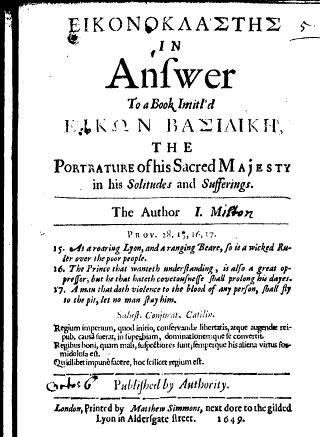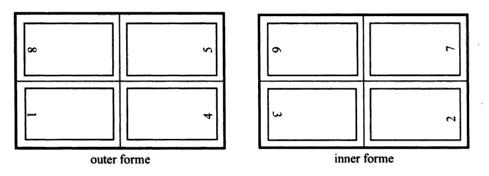There is an interesting discussion going on over at the SHARP e-mail list about the differences between reading on paper and reading on a screen.The conclusion of most posters is that while we may not need a new word to describe reading on a screen – viewing? screening? diging? – there is nevertheless a difference between the two. Defining that difference, on the other hand, is a bit harder and is something many scholars are still thinking about.
I blogged about this a while ago, in the context of Early English Books Online (EEBO) and whether reading seventeenth-century pamphlets on screen can change how you read them. Prompted by the SHARP discussion, I’ve been doing some more thinking about this. It occurred to me that this has been an interpretative issue since before the creation of EEBO and other digital reproductions of sources. Microfilm versions of pamphlets also carry with them some of the same issues.
In the case of the Thomason Tracts, for example, a microfilm edition by University Microfilms International (UMI) has existed since 1977. This is the way that most scholars have probably read them between that time until a few years ago. Although you can print out pamphlets from both EEBO and from microfilm, both methods of access are primarily through a screen. So what are the similarities and differences between reading a pamphlet in its original format, via a microfilm reader, or through your computer monitor? And do the differences make any practical impact on how you absorb and understand the text?
My own answer is that I’m not completely sure, but I feel instinctively that there must be differences, which in turn must impact on the experience of reading. But I was worried that this instinct is more to do with the book historians I’ve been reading – for whom the importance of the reader is a pre-requisite – than anything that could be demonstrated empirically. So here are a few thoughts about how those differences might actually have a practical impact on reception.
One is colour. A bit obvious, perhaps, but microfilm often only reproduces texts in black and white. This is certainly the case with the Thomason Tracts, and in turn EEBO reproduces the microfilm edition of them so retains this monochrome reproduction. This can potentially blur the subtleties of early modern printing. Here for example are two images of the title page of John Milton’s Eikonoklastes (unfortunately I couldn’t find two versions of the same copy, although they are the same edition):


The notes page on EEBO does say that the title page is in red and black, and if you look closely you can distinguish in places where it must have been red. But it’s still very unclear. Why does this matter? One reason is in helping to distinguish between the impact of author and printer on the finished text. Was it the printer Matthew Simmons, or the author Milton, who decided to use red ink – which would have complicated the printing process significantly? Another reason is in thinking about the impact the text had on its readers. How would they have read the title page? Does it matter that the Greek letters are printed in a different colour, given that many readers would not have understood them? Does it matter that “Published by Authority” is in red, given the severe Licensing Act that the Rump Parliament had passed the month before publication had re-introduced pre-publication censorship. To answer these questions properly, you really need to look at the original edition.
Another is environment. The original Thomason Tracts have to be read in the British Library. Typically the microfilm version would also have to be read in a university library, unless you could persuade the librarian to run off copies. This imposes certain physical conditions, such as near-silence, the presence of other scholars, and the absence of other distractions. You can read EEBO at home in your dressing gown. I certainly work differently in libraries when I know I’m probably going to be there for most of the day, compared to at home where I might be snatching half an hour to have a look at something. Looking at EEBO, you also have the rest of the internet to distract you. You can imagine spotting things in one state that you might not in the other. One silly example of mine is searching late at night for something and forgetting that EEBO’s search engine doesn’t automatically include AND for strings of words. Two weeks later when I tried again at a more sensible hour I found what I was looking for. On the other hand, being able to read EEBO outside library hours does increase the time you have available to work on it. For time-limited projects like dissertations, this can make a big difference to the amount of texts you are able to read or the amount of analysis you are able to devote to a text.
A third is searchability. Apart from wider short-title catalogues, the Thomason Tracts have been catalogued at least three times: once by Thomason himself, secondly by G.K. Fortescue in a two volume edition published in 1908, and thirdly by the UMI microfilm edition. Before EEBO, you were reliant on these indexes, compiled by someone else with limited search variables, to find what you were looking for. Now you can search not just for author and title but also for subjects and keywords. Fortescue also altered Thomason’s cataloguing order and sometimes gives his own dates. In turn Thomason’s dates are more idiosyncratic than used to be thought, and don’t necessarily mean the day the pamphlet was actually published. The UMI catalogue then restored Thomason’s cataloguing. Using EEBO lets you search by Thomason’s ordering, but also by your own. Inevitably this gives you much more freedom to navigate the collection and find new things. Particularly powerful is the gradual conversion to free text that EEBO are making of early modern pamphlets. This in particular is still a greatly untapped feature when it comes to identifying links between texts, making authorial attributions, and so on. But while such freedom has its benefits – making connections that would perhaps not have been possible otherwise – it can also have its drawbacks in terms of making mistaken connections, as the story about William Lilly in the latest edition of Early Modern Literary Studies makes clear.
There is also the fact that pamphlets are three-dimensional objects made of particular materials. Again it is almost banal to point it out, but microfilm and EEBO reproduce these objects in two dimensions. Here is a title page from the royalist newsbook Mercurius Elencticus, singled out by Jason McElligott in his study of the later royalist newsbooks as an example of one printed on particularly thin paper:

You can partly deduce this from the digital version by the fact that print from the other side of the page has leached through, but you can’t get any real sense of comparison with other issues or other titles. Again, why does this matter? Partly because paper quality can tell us something about the cost of the title – how much the printer was prepared to invest in it, how much it sold for – and something about the audience – who could afford it. But in the royalist newsbooks’ case it also relates to the fact that they were produced underground in opposition to a strident Parliamentarian censorship regime, with limited access to raw materials, and printers had to make do with what they could.
Then there is the issue of resolution. All three types of media are ultimately viewed with the naked eye, but there are various ways they are mediated before we see them. Original pamphlets can be zoomed in on with a magnifying glass. Microfilm and EEBO versions can be zoomed in on mechanically or digitally. The resolution at which EEBO reproduces pamphlets could be an issue here – they can get slightly pixellated if you are looking at them at a particularly high level of zoom. On the other hand, it’s much easier to zoom on a computer than it is by hand. A ractical example of this is a pamphlet called The Perfect Politician about Oliver Cromwell, by a pseudonymous author. In his 1990 essay on Cromwell’s contemporaries, John Morrill identifies this as being by L.S.

It certainly does look like L.S. When you zoom in, though, it seems clear that it is probably by I.S and that L.S. is a misreading because of the full stop merging into the I.

The pamphlet is probably by John [Iohn] Streater, a radical and veteran of the New Model Army. Knowing this puts the pamphlet in a very different context. So the ease with which type can be examined through EEBO – despite issues with resolution – may well have an important role in bibliographic analysis of texts that have otherwise been well-examined.
These are some initial thoughts about the differences between original sources, microfilm and digital reproductions. I’m sure you’ll have more – what do you think? But in closing it occurs to me that all three have an important similarity. One thing that original pamphlet, microfilm and EEBO all have in common is a relatively static bibliographical apparatus. They all still draw on Wing’s Short-Title Catalogue of Books Printed in England, Scotland, Ireland, Wales and British America and of English Books Printed in Other Countries 1641-1700. Some of the attributions in Wing can be dubious. The Perfect Politician is a good example of this. Here is what the information page in EEBO says:
Attributed to Henry Fletcher by Wing.
Sometimes attributed to William Raybould.
A quick look at the title page makes it obvious that Fletcher and Raybould are the booksellers, not the authors.

This misattribution is fairly easily sorted out. However there are others where it’s not so clear, or where recent scholarship has moved beyond Wing but EEBO doesn’t reference this. For me a great improvement to EEBO would be to give users the ability to set up an account with a real-life identity and let them annotate texts. You would know which scholars were working on something of interest to you; you would be able to flag where you disagreed with an attribution, giving reasons; and you could contact the person who’d made an annotation to ask them about any attributions you were unsure of. Until bibliographical catalogues go properly digital, there will remain this odd juxtaposition between digital texts and analogue descriptions.






 I’ve been reading Edward Sexby’s
I’ve been reading Edward Sexby’s 